Gabriel
In the Abrahamic religions, Gabriel (/ˈɡeɪbriəl/)[N 2] is an archangel who appears in the Hebrew Bible, the New Testament, and the Quran.
Gabriel | |
|---|---|
_-_WGA17770.jpg.webp) Detail of Gabriel from Pinturicchio's The Annunciation (1501) | |
| Archangel, Angel of Revelation, Commander of the Powers | |
| Venerated in | Judaism Samaritanism All Christian denominations which venerate saints Islam and others[N 1] |
| Canonized | Pre-Congregation |
| Feast |
|
| Attributes | Archangel;[1] Clothed in blue or white garments;[2] Carrying a lily,[2][3] a trumpet,[2] a shining lantern,[2] a branch from Paradise,[2] a scroll,[3] and a scepter.[3] |
| Patronage | Telecommunication workers,[4][5] radio broadcasters,[5] messengers,[5] postal workers,[5] clerics,[5] diplomats,[5] stamp collectors,[5] Portugal, Santander, Cebu, ambassadors |
In the Hebrew Bible, Gabriel appears to the prophet Daniel to explain his visions (Daniel 8:15–26, 9:21–27). The archangel also appears in the Book of Enoch and other ancient Jewish writings. Alongside the archangel Michael, Gabriel is described as the guardian angel of Israel, defending its people against the angels of the other nations. Gabriel is also translated as "strength of God" in some languages.[6]
_Gabriel.jpg.webp)
The Gospel of Luke relates the stories of the Annunciation, in which the angel Gabriel appears to Zechariah and the Virgin Mary, foretelling the births of John the Baptist and Jesus, respectively (Luke 1:11–38). Many Christian traditions—including Anglicanism, Eastern Orthodoxy, and Roman Catholicism—revere Gabriel as a saint.[1][7]
Islam regards Gabriel as an archangel sent by God to various prophets, including Muhammad.[8] The first five verses of the Al-Alaq, the 96th chapter of the Quran, is believed by Muslims to have been the first verses revealed by Gabriel to Muhammad.[8]
The Church of Jesus Christ of Latter-day Saints hold that the angel Gabriel is the same individual as the prophet Noah.[9][10]
According to one ancient Gnostic manuscript, the Holy Book of the Great Invisible Spirit, Gabriel is a divine being and inhabitant of the Pleroma who existed prior to the Demiurge.[11]
Yazidis consider Gabriel one of the Seven Mysteries, the heptad to which God entrusted the world, and sometimes identified with the archangel Melek Taus.[12]
Judaism
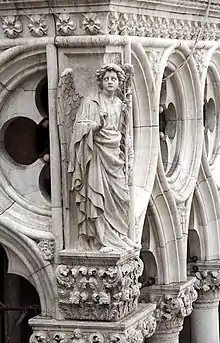
Gabriel, (Hebrew: גַּבְרִיאֵל, romanized: Gaḇrīʾēl) is interpreted by Talmudic rabbis to be the "man in linen" as in the Book of Daniel and the Book of Ezekiel. In the Book of Daniel, Gabriel is responsible for interpreting Daniel's visions. Gabriel's main function in Daniel is that of revealer, a role he continues in later literature. In the Book of Ezekiel, Gabriel is understood to be the angel that was sent to destroy Jerusalem. According to the Jewish Encyclopedia, Gabriel takes the form of a man, and stands at the left hand of God.[13] Shimon ben Lakish (Syria Palaestina, 3rd century) concluded that the angelic names of Michael, Raphael, and Gabriel came out of the Babylonian exile (Gen. Rab. 48:9).[14] Alongside archangel Michael, Gabriel is described as the guardian angel of Israel, defending this people against the angels of the other nations.[6]
In Kabbalah, Gabriel is identified with the sephirah of Yesod. Gabriel also has a prominent role as one of God's archangels in the Kabbalah literature. There, Gabriel is portrayed as working in concert with Michael as part of God's court. Gabriel is not to be prayed to because only God can answer prayers and sends Gabriel as his agent.[13]
According to Jewish mythology, in the Garden of Eden there is a tree of life or the "tree of souls"[15] that blossoms and produces new souls, which fall into the Guf, the Treasury of Souls. Gabriel reaches into the treasury and takes out the first soul that comes into his hand. Then Lailah, the Angel of Conception, watches over the embryo until it is born.
Intertestamental literature
The intertestamental period (roughly 200 BC – 50 AD) produced a wealth of literature, much of it having an apocalyptic orientation. The names and ranks of angels and devils were greatly expanded, and each had particular duties and status before God.
In 1 Enoch 9:1–3, Gabriel, along with Michael, Uriel and Suriel, "saw much blood being shed upon the earth" (9:1) and heard the souls of men cry, "Bring our cause before the Most High" (9:3). In 1 Enoch 10:1, the reply came from "the Most High, the Holy and Great One" who sent forth agents, including Gabriel—
And the Lord said to Gabriel: "'Proceed against the bastards and the reprobates, and against the children of fornication: and destroy [the children of fornication and] the children of the Watchers from amongst men [and cause them to go forth]: send them one against the other that they may destroy each other in battle: for length of days shall they not have."
Gabriel is the fifth of the five angels who keep watch: "Gabriel, one of the holy angels, who is over Paradise and the serpents and the Cherubim" (1 Enoch 20:7).
When Enoch asked who the four figures were that he had seen:
And he said to me: 'This first is Michael, the merciful and long-suffering: and the second, who is set over all the diseases and all the wounds of the children of men, is Raphael: and the third, who is set over all the powers, is Gabriel: and the fourth, who is set over the repentance unto hope of those who inherit eternal life, is named Phanuel.' And these are the four angels of the Lord of Spirits and the four voices I heard in those days.
Christianity
New Testament
.jpg.webp)
First, concerning John the Baptist, an angel appeared to his father Zacharias, a priest of the course of Abia, (Luke 1:5–7) whose barren wife Elisabeth was of the daughters of Aaron, while he ministered in the temple:
10 And the whole multitude of the people were praying without at the time of incense.
11 And there appeared unto him an angel of the Lord standing on the right side of the altar of incense.
12 And when Zacharias saw him, he was troubled, and fear fell upon him.
13 But the angel said unto him, Fear not, Zacharias: for thy prayer is heard; and thy wife Elisabeth shall bear thee a son, and thou shalt call his name John.
14 And thou shalt have joy and gladness; and many shall rejoice at his birth.
15 For he shall be great in the sight of the Lord, and shall drink neither wine nor strong drink; and he shall be filled with the Holy Ghost, even from his mother's womb.
16 And many of the children of Israel shall he turn to the Lord their God.
17 And he shall go before him in the spirit and power of Elias, to turn the hearts of the fathers to the children, and the disobedient to the wisdom of the just; to make ready a people prepared for the Lord.
18 And Zacharias said unto the angel, Whereby shall I know this? for I am an old man, and my wife well stricken in years.
19 And the angel answering said unto him, I am Gabriel, that stand in the presence of God; and am sent to speak unto thee, and to shew thee these glad tidings.
20 And, behold, thou shalt be dumb, and not able to speak, until the day that these things shall be performed, because thou believest not my words, which shall be fulfilled in their season.— Luke 1:10-20[16]
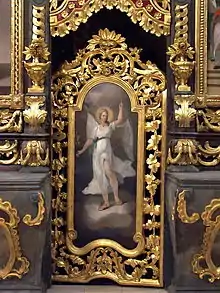
After completing his week[17] of ministry, Zacharias returned to his home and his wife Elizabeth conceived. After she completed "five months" (Luke 1:21–25) of her pregnancy, Gabriel is mentioned again:
26 And in the sixth month the angel Gabriel was sent from God unto a city of Galilee, named Nazareth,
27 To a virgin espoused to a man whose name was Joseph, of the house of David; and the virgin's name was Mary.
28 And the angel came in unto her, and said, Hail, thou that art highly favoured, the Lord is with thee: blessed art thou among women.
29 And when she saw him, she was troubled at his saying, and cast in her mind what manner of salutation this should be.
30 And the angel said unto her, Fear not, Mary: for thou hast found favour with God.
31 And, behold, thou shalt conceive in thy womb, and bring forth a son, and shalt call his name JESUS.
32 He shall be great, and shall be called the Son of the Highest: and the Lord God shall give unto him the throne of his father David:
33 And he shall reign over the house of Jacob for ever; and of his kingdom there shall be no end.
34 Then said Mary unto the angel, How shall this be, seeing I know not a man?
35 And the angel answered and said unto her, The Holy Ghost shall come upon thee, and the power of the Highest shall overshadow thee: therefore also that holy thing which shall be born of thee shall be called the Son of God.
36 And, behold, thy cousin Elisabeth, she hath also conceived a son in her old age: and this is the sixth month with her, who was called barren.
37 For with God nothing shall be impossible.
38 And Mary said, Behold the handmaid of the Lord; be it unto me according to thy word. And the angel departed from her.— Luke 1:26-38[18]
Gabriel only appears by name in those two passages in Luke. In the first passage the angel identified himself as Gabriel, but in the second it is Luke who identified him as Gabriel. The only other named angels in the New Testament are Michael the Archangel (in Jude 1:9) and Abaddon (in Revelation 9:11). Gabriel is not called an archangel in the Bible. Believers are expressly warned not to worship angels (in Colossians 2:18–19 and Revelation 19:10).[19]
Gabriel's horn
The trope of Gabriel blowing a trumpet blast to indicate the Lord's return to Earth is especially familiar in Spirituals. However, though the Bible mentions a trumpet blast preceding the resurrection of the dead, it never specifies Gabriel as the trumpeter. Different passages state different things: the angels of the Son of Man (Matthew 24:31); the voice of the Son of God (John 5:25-29); God's trumpet (I Thessalonians 4:16); seven angels sounding a series of blasts (Revelation 8-11); or simply "a trumpet will sound" (I Corinthians 15:52).[20]
In related traditions, Gabriel is again not identified as the trumpeter. In Judaism, trumpets are prominent, and they seem to be blown by God himself, or sometimes Michael. In Zoroastrianism, there is no trumpeter at the last judgment. In Islamic tradition, it is Israfil who blows the trumpet, though he is not named in the Qur'an. The Christian Church Fathers do not mention Gabriel as the trumpeter; early English literature similarly does not.[20]
The earliest known identification of Gabriel as the trumpeter comes in the Hymn of the Armenian Saint Nerses Shnorhali, "for Protection in the Night":[21]
The sound of Gabriel's trumpet on the last night, make us worthy to hear, and to stand on your right hand among the sheep with lanterns of inextinguishable light; to be like the five wise virgins, so that with the bridegroom in the bride chamber we, his spiritual brides may enter into glory.
In 1455, in Armenian art, there is an illustration in an Armenian manuscript showing Gabriel sounding his trumpet as the dead climb out of their graves.[22] Two centuries later, Gabriel is identified as the trumpeter, in John Milton's Paradise Lost (1667):[20][23]
Betwixt these rockie pillars Gabriel sat
Chief of the Angelic guards (IV.545f)...
He ended, and the Son gave signal high
To the bright minister that watch'd, he blew
His trumpet, heard in Oreb since perhaps
When God descended, and perhaps once more
To sound at general doom. (XI.72ff).
Later, Gabriel's horn is omnipresent in Negro spirituals, but it is unclear how the Byzantine conception inspired Milton and the spirituals, though they presumably have a common source.[20]
Gabriel's horn also makes an appearance in "The Eyes of Texas" (1903) in which it signifies the rapture.[24] In Marc Connelly's play based on spirituals, The Green Pastures (1930), Gabriel has his beloved trumpet constantly with him, and the Lord has to warn him not to blow it too soon.[20] Four years later "Blow, Gabriel, Blow" was introduced by Ethel Merman in Cole Porter's Anything Goes (1934).
Feast days
Saint Gabriel the Archangel's festival day was exclusively celebrated on 18 March according to many sources dating between 1588 and 1921; unusually, a source published in 1856[25] has the feast celebrated on 7 April for unknown reasons (a parenthetical note states that the day is normally celebrated on 18 March). Writer Elizabeth Drayson mentions the feast being celebrated on 18 March 1588 in her 2013 book "The Lead Books of Granada".[26]
One of the oldest out-of-print sources placing the feast on 18 March, first published in 1608, is "Flos sanctorum: historia general de la vida y hechos de Jesu-Christo...y de los santos de que reza y haze fiesta la Iglesia Catholica..." by the Spanish writer Alonso de Villegas; a newer edition of this book was published in 1794.[27] Another source published in Ireland in 1886 the Irish Ecclesiastical Record also mentions 18 March.[28]
The feast of Saint Gabriel was included by Pope Benedict XV in the General Roman Calendar in 1921, for celebration on 24 March.[29] In 1969 the day was officially transferred to 29 September for celebration in conjunction with the feast of the archangels St. Michael and St. Raphael.[30] The Church of England has also adopted the 29 September date, known as Michaelmas.
The Eastern Orthodox Church and those Eastern Catholic Churches which follow the Byzantine Rite celebrate his feast day (Synaxis of the Archangel Michael and the Other Bodiless Powers) on 8 November (for those churches that follow the traditional Julian Calendar, 8 November currently falls on 21 November of the modern Gregorian Calendar, a difference of 13 days). Eastern Orthodox commemorate him, not only on his November feast, but also on two other days:
- 26 March is the "Synaxis of the Archangel Gabriel" and celebrates his role in the Annunciation (eavetaking of the Annunciation),
- 13 July is also known as the "Synaxis of the Archangel Gabriel", and celebrates all the appearances and miracles attributed to Gabriel throughout history. The feast was first established on Mount Athos when, in the 9th century, during the reign of Emperor Basil II and the Empress Constantina Porphyrogenitus and while Nicholas Chrysoverges was Patriarch of Constantinople, the Archangel appeared in a cell[31] near Karyes, where he wrote with his finger on a stone tablet the hymn to the Theotokos, "It is truly meet...".[32]
Saint Gabriel the Archangel is commemorated on the vigil of Annunciation (24 March) by Antiochian Western Rite Vicariate[33] and ROCOR Western Rite.[34]
The Coptic Orthodox Church celebrates his feast on 13 Paoni,[35] 22 Koiak and 26 Paoni.[36]
The Ethiopian Church celebrates his feast on 18(in the Ethiopian calendar) December, with a sizeable number of its believers making a pilgrimage to a church dedicated to "Saint Gabriel" in Kulubi and Wonkshet on that day.[37]
Additionally, Gabriel is the patron saint of messengers, those who work for broadcasting and telecommunications such as radio and television, postal workers, clerics, diplomats, and stamp collectors.[5]
Latter-day Saint teachings
In The Church of Jesus Christ of Latter-day Saints theology, Gabriel is believed to have lived a mortal life as the prophet Noah. The two are regarded as the same individual; Noah being his mortal name and Gabriel being his heavenly name.[9][10]
Islam
Gabriel (Arabic: جِبْرِيل, romanized: Jibrīl; also Arabic: جبرائيل, romanized: Jibrāʾīl or Jabrāʾīl; derived from the Hebrew: גַּבְרִיאֵל, romanized: Gaḇrīʾēl)[8][38][39][40] is venerated as one of the primary archangels and as the Angel of Revelation in Islam.[8][38][39] He is primarily mentioned in the verses 2:97, 2:98, and 66:4 of the Quran, although the Quranic text doesn't explicitly refer to him as an angel.[38] In the Quran, the archangel Gabriel appears named in 2:97 and 66:4, as well as in 2:98, where he is mentioned along with the archangel Michael (Mīkāʾīl).[8]
Exegetical Quranic literature narrates that Muhammad saw the archangel Gabriel in his full angelic splendor only twice, the first time being when he received his first revelation.[39] As the Bible portrays Gabriel as a celestial messenger sent to Daniel,[41] Mary,[42] and Zechariah,[43] Islamic tradition holds that Gabriel was sent to numerous pre-Islamic Biblical prophets with revelation and divine injunctions, including Adam, whom Muslims believe was consoled by Gabriel some time after the Fall, too.[44] He is known by many names in Islam, such as "keeper of holiness".[45] In Hadith traditions, Jibril is said to have six hundred wings.[46]
Tasks
Muslims believe that Gabriel was mainly tasked with transmitting the scriptures from God to the prophets and messengers, as Asbab al-Nuzul or revelation of Al-Baqara, Ayah 124|Quran 3:124 (Translated by Shakir) when Muhammad was questioned which angel is revealing the holy scriptures revelation, and Muhammad told the Jews it is revealed by Gabriel who is tasked to it.[47]
Muslims also revere Gabriel for a number of events predating what they regard as the first revelation, narrated in the Quran. Muslims believe that Gabriel was the angel who informed Zachariah (Zakariyyā) of Yaḥyā's (John's) birth, as well as Mary (Maryam) of the future nativity of Jesus;[48][49] and that Gabriel was one of three angels who had earlier informed Abraham (ʾIbrāhīm) of the birth of Isaac (ʾIsḥāq) [51:24-30].[50] Gabriel also makes a famous appearance in the Hadith of Gabriel, in which he questions Muhammad on the core tenets of Islam.[8]
Gabriel is also believed to have delivered punishment from God to the Sodomite by leveling the entire Sodom city with a tip of his wing.[51] According to a Hadith narrated by Abu Dharr al-Ghifari, which is compiled by al-Hakim al-Tirmidhi, Gabriel has an ability to regulate Feeling or Perception of human, particularly a feel of happiness or sadness.[52]
Gabriel is believed to have helped Muhammad overcome his adversaries significantly against a demon (ʻifrīt) during the Mi'raj.[53][54] Gabriel is believed to have helped Muhammad overcome his adversaries during the Battle of Badr, where according to scholars and clerics of Islam, the various hadiths, both authentics and inauthentics, has mentioned that Gabriel,[55] Michael, Raphael,[56][N 3][N 4] and thousands of best angels from third level of sky, all came to the battle of Badr by impersonating appearance of Zubayr ibn al-Awwam, a Companions of the Prophet and bodyguard of the prophet.[N 5][61] This is deemed as Zubayr personal honor according to Islamic belief.[62][63][N 6] Meanwhile, Safiur Rahman Mubarakpuri has recorded in his historiography works of Quran and Hadith revelation in Prophetic biography, that Sa'd ibn Abi Waqqas testified he saw two unidentified warriors clad in white has protected Muhammad during the Battle of Uhud, That later being confirmed by Muhammad those two unidentified warriors were Jibril and Mikail in disguise.[65]
Moreover, he is believed to have further encouraged Muhammad to wage war and attack the Jewish tribe of Banu Qurayza.[38][66] Another appearance of Gabriel in Islamic religious texts were found in numerous Hadiths during the Battle of Hunayn, where the Gabriel stood next to Muhammad.[67]
Other Islamic texts and some Apocryphal literature also supported Gabriel's role as a celestial warrior.[38][68] Though alternate theories exist, whether the occurrence of the Holy Spirit in the Quran refers to Gabriel or not, remains an issue of scholarly debate. However, a clear distinction between apocryphal and Quranic references to Gabriel is that the former doesn't designate him as the Holy Spirit in the First Book of Enoch, which narrates the story of Gabriel defeating the Nephilim.[38]
Art, entertainment, and media
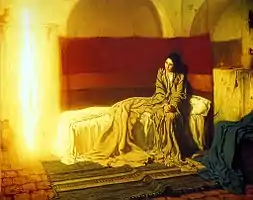
Angels are described as pure spirits.[69][70] The lack of a defined form allows artists wide latitude in depicting them.[71] Amelia R. Brown draws comparisons in Byzantine iconography between portrayals of angels and the conventions used to depict court eunuchs. Mainly from the Caucasus, they tended to have light eyes, hair, and skin; and those "castrated in childhood developed a distinctive skeletal structure, lacked full masculine musculature, body hair and beards...." As officials, they would wear a white tunic decorated with gold. Brown suggests that "Byzantine artists drew, consciously or not, on this iconography of the court eunuch."[72] Some recent popular works on angels consider Gabriel to be female or androgynous.[73][74]
Gabriel sculptures
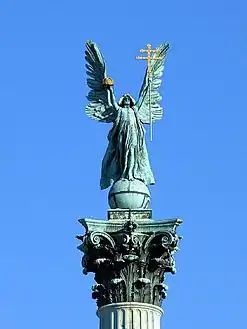 Archangel Gabriel Millennium Monument at Heroes' Square in Budapest
Archangel Gabriel Millennium Monument at Heroes' Square in Budapest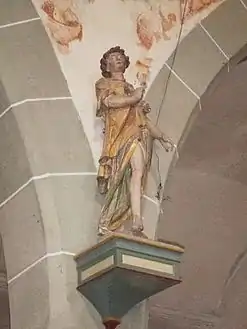 Archangel Gabriel in the church of St. Georg in Bermatingen
Archangel Gabriel in the church of St. Georg in Bermatingen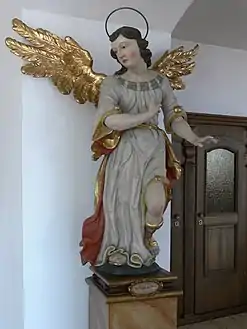 Archangel Gabriel in the church of St. Magnus in Waldburg
Archangel Gabriel in the church of St. Magnus in Waldburg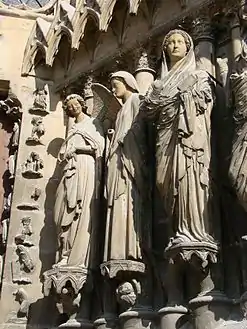 Archangel Gabriel at the façade of the Cathedral of Reims
Archangel Gabriel at the façade of the Cathedral of Reims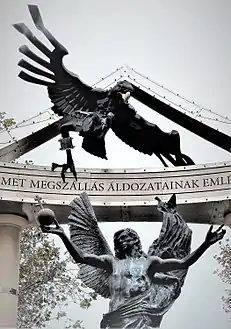 Archangel Gabriel at the Liberty Square, Budapest
Archangel Gabriel at the Liberty Square, Budapest
Festivals
- Baltimore's "Little Italy" has for over 80 years hosted an annual "end of summer" St. Gabriel Festival that features a procession with a statue of the saint carried through the streets.[75][76]
_The_Annunciation%252C_Gabriel_kneeling_on_one_knee.jpg.webp)
Film
- In Liliom (1930), Gabriel is portrayed by Harvey Clark.
- In The Green Pastures (1936), Gabriel is portrayed by Oscar Polk.
- In Heaven Only Knows (1947), Gabriel was portrayed by William Farnum.
- In The Littlest Angel (1969; television film), Gabriel is portrayed by Cab Calloway.
- In horror film The Prophecy (1995), Gabriel (portrayed by Christopher Walken) searches for an evil soul on Earth during an end-of-days angelic civil war. He is also a character in The Prophecy II (1998) and The Prophecy 3: The Ascent (2000).
- In Mary, Mother of Jesus (1999; television film), Gabriel is portrayed by John Light.
- In the fantasy/horror film Constantine (2005), Tilda Swinton portrays an androgynous archangel Gabriel.
- In the action/horror film Gabriel (2007), the eponymous character (portrayed by Andy Whitfield) fights to save the souls in purgatory by defeating the evil fallen angels.
- In the apocalyptic supernatural action film Legion (2010), Kevin Durand plays the role of Archangel Gabriel, the leader of the angel army, and the main antagonist. The story was continued in the TV series Dominion .
Games
- 2005: Spanish role-playing game Anima: Beyond Fantasy - Gabriel is as the humans know one of the seven "Beryls" (godlike beings of light) and is identified with the archangel of the same name. She has associated love, friendship, arts, and peace.
- In the Japanese role-playing game Shin Megami Tensei - Gabriel is one of the Demons the player can summon to assist in battle.
- In the video game El Shaddai: Ascension of the Metatron, based on the Book of Enoch, Gabriel is featured alongside Michael, Raphael, and Uriel as a guide for Enoch on his quest. All four archangels take the form of swans while on Earth. Gabriel is depicted as female in this interpretation and implied to be an angel of wisdom. She is associated with the Veil weapon Enoch uses.
- In Ultrakill, a retro first-person shooter, Gabriel is featured as one of the bosses and a primary story character.
- In The Binding of Isaac (video game), a roguelike dungeon crawler, the player is able to fight Gabriel and Uriel to obtain their key pieces in order to fight Mega Satan.
Literature
- In his epic poem Paradise Lost, John Milton made Gabriel chief of the angelic guards placed over Paradise
- The Hebrew poem "Elifelet" (אליפלט) by Nathan Alterman, put to music and often heard on the Israeli Radio, tells of a heroic, self-sacrificing Israeli soldier being killed in battle. Upon the protagonist's death, the angel Gabriel descends to Earth, in order to comfort the spirit of the fallen hero and take him up to Heaven[77][78]
- The main character of Salman Rushdie's The Satanic Verses (1988) believes that he is the modern incarnation of Gabriel.
- In the Japanese light novel series No Game No Life (2012), Jibril is a member of the Flügel race and was a member of the Council of 18 Wings, a prominent section in the government. She is depicted as loving knowledge and books.
- In volume 3 of the Japanese light novel series The Devil Is a Part-Timer!, an archangel named Gabriel appeared and is the guardian of the Sephirah Yesod.
- In the Japanese light novel High School DxD features Gabriel as one of the Four Great Seraph whom are the highest ranking Seraph alongside Michael, Uriel and Raphael. In the novel, Gabriel is depicted as a female angel with immense angelic beauty and is given the titles of "The Strongest Woman in Heaven" and "The Most Beautiful Woman in Heaven".
- In August Wilson's Fences (1985), the mentally handicapped character Gabriel believes with every fibre of his soul that he is the Archangel Gabriel. He carries around a trumpet on him always, and strives to chase away the "hellhounds". In the last scene of the play, he calls for Saint Peter to open up the gates.
Music
- The eccentric English hagiographer and antiquarian, Sabine Baring-Gould (1834–1924) wrote "Gabriel's Message", the English translation of the Basque Christmas carol Birjina gaztetto bat zegoen. The original charol is likely related to the 13th or 14th-century Latin chant Angelus Ad Virginem, which itself is based on the biblical account of the Annunciation in the Gospel of Luke.
- In "My Own Prison" by Creed, Gabriel is mentioned as deciphering the visions to the main character in the song.
- "Sugar Baby", the last track on Bob Dylan's Love and Theft album, contains this reference:
"Just as sure as we're living, just as sure as we're born
Look up, look up - seek your Maker - 'fore Gabriel blows his horn.
- "Blow Your Trumpets Gabriel" by Polish black metal band Behemoth.
- The 1996 garage/house song "Gabriel" by Roy Davies Jnr (featuring vocals from Peven Everett) is about the archangel Gabriel. In the chorus, Everett can be heard singing "Gabriel play" in reference to Gabriel's trumpet. A trumpet is also heard in the song right after this line is sung.
Visual art
- See also Gabriel gallery in Commons.
.jpg.webp)
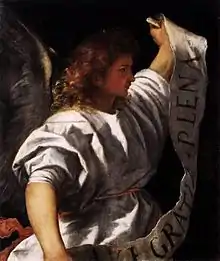
Daniel 8:15 describes Gabriel as appearing in the "likeness of man" and in Daniel 9:21 he is referred to as "the man Gabriel". David Everson observes that "such anthropomorphic descriptions of an angel are consistent with previous...descriptions of angels," as in Genesis 19:5.[14]
Gabriel is most often portrayed in the context of scenes of the Annunciation. In 2008 a 16th-century drawing by Lucas van Leyden of the Netherlands was discovered. George R. Goldner, chairman of the department of prints and drawings at New York's Metropolitan Museum of Art, suggested that the sketch was for a stained glass window. "The fact that the archangel is an ordinary-looking person and not an idealized boy is typical of the artist", said Goldner.[79]
In chronological order (to see each item, follow the link in the footnote):[80]
- Archangel Gabriel (Triptych), early 10th century, Benaki Museum
- The Archangel Gabriel, Pisan, c. 1325–50, National Gallery of Art
- The Archangel Gabriel, Masolino da Panicale, c. 1420–30, National Gallery of Art
- Justice between the Archangels Michael and Gabriel, Jacobello del Fiore, 1421
- Merode Altarpiece (Triptych), Robert Campin, c. 1425, Metropolitan Museum of Art
- The Angel Gabriel, Agostino di Duccio, c. 1450
- Annunciation, Leonardo da Vinci, c. 1475
- The Angel Gabriel, Neroccio d'Landi, c. 1490
- The Angel Gabriel, late 15th or early 16th century, Flemish, National Gallery of Art
- The Angel Gabriel, Ferrari Gaudenzio, 1511, National Gallery, London
- Gabriel delivering the Annunciation El Greco, 1575 (pictured above)
- Go Down Death, Aaron Douglas, 1934
The Military Order of Saint Gabriel was established to recognize "individuals who have made significant contributions to the U.S. Army Public Affairs community and practice." The medallion depicts St. Gabriel sounding a trumpet, while the obverse displays the Army Public Affairs emblem.[81]
Television
- The Twilight Zone (1960) episode "A Passage for Trumpet" – The down-and-out musician Joey Crown (Jack Klugman) meets an enigmatic trumpet player named "Gabe" (played by John Anderson), in what has been described as Rod Serling's version of It's a Wonderful Life.[82]
- Supernatural (2005) – Gabriel, portrayed by Richard Speight Jr., is a runaway archangel who kills people he deems evil, also interacting with other angels, including his siblings Michael, Raphael, and Lucifer.
- Dominion (2014) – Gabriel, portrayed by Carl Beukes, is the series antagonist, who plans to kill the Archangel Michael and annihilate humanity.
- Now Apocalypse (2019) – Gabriel, portrayed by Tyler Posey, is an enigmatic trumpet player who has a passionate tryst with series protagonist Ulysses Zane before warning him about an impending apocalypse.
- Amazon Prime miniseries Good Omens (2019) – Gabriel is portrayed by Jon Hamm. The show is based on the novel by Terry Pratchett and Neil Gaiman.
See also
- Angel of the Lord
- Angelus
- Annunciation
- Christian angelic hierarchy
- Fleur de lys
- Gabriel's Horn, a mathematical figure
- Hermes
- List of angels in theology
- List of names referring to El
- Ptahil-Uthra also identified as Gabriel in Mandaeism
- Saint Gabriel, patron saint archive
- Seraph
References
Notes
- Including, but not limited to: Yazidism, Mormonism, Rastafari, Bábism, and the Baháʼí Faith.
- Hebrew: גַּבְרִיאֵל, romanized: Gaḇrīʾēl, "God is my mighty man"; Greek: Γαβριήλ, Gabriḗl; Latin: Gabriel; Coptic: Ⲅⲁⲃⲣⲓⲏⲗ, Gabriêl; Amharic: ገብርኤል, Gabrəʾel; Imperial Aramaic: ܓ݁ܰܒ݂ܪܺܝܐܝܶܠ, romanized: Gaḇrīʾēl; Arabic: جِبْرِيل, romanized: Jibrīl, also Arabic: جبرائيل, romanized: Jibrāʾīl or Jabrāʾīl
- Found in Mustadrak al Sahihayn.[57] The complete narration from Al-Hakim al-Nishapuri were:... Abu Abdullah Muhammad bin Yaqoub has reported from Ibrahim bin Abdullah Al-Saadi, who told us Muhammad bin Khalid bin Uthma, told us Musa bin Yaqoub, told me Abu Al-Huwairith, that Muhammad bin Jubayr bin Mut’im told him, that he heard Ali - may God be pleased with him - addresses the people, and he said: While I was leaving from the well of Badr, a strong wind came, the like of which I had never seen, then it left, then came a strong wind, the like of which I have never seen except for the one before it, then it went, then came a strong wind that I did not see before. I have never seen anything like it except for the one before it, and the first wind was Gabriel descended among a thousand angels with the Messenger of God - may God bless him and grant him peace - and the second wind was Michael who descended among a thousand angels to the right of the Messenger of God - may God bless him and his family and grant them peace - and Abu Bakr was On his right, and the third wind was Israfil. He descended with a thousand angels on the side of the Messenger of God - may God's prayers and peace be upon him and his family - and I was on the right side. When God Almighty defeated his enemies, the Messenger of God - may God's prayers and peace be upon him and his family - carried me on his horse, I blew up, and I fell On my heels, I prayed to God Almighty... Ibn al Mulqin, Hadith scholar from Cordoba of 13-14 AD century, evaluate this hadith that he found weaknesses in Musa ibn Yaqoub and Abu al Huwairith chain, so he deemed there is weakness about this hadith.[58] However, recent scholarship from Ali Hasan al-Halabi has noted there is another hadith which supported the participation of Raphael in Badr[56]
- According to Islamic belief in weak chain of Hadith, Raphael were acknowledged as angel who were tasked to blower of Armageddon trumpet, and one of archangels who bear the Throne of God on their back.[59]
- According to one Hadith, Muhammad were told that the angels that appeared in the battle of Badr were highest in status and the "best of angels" according to Gabriel in Hadith narrated by Muhammad.[60]
- According to one narration, during the battle, Muhammad has found an angel whom he though as Zubayr standing next to him, which then prompted Muhammad to command him to attack, which the angel, in Zubayr appearance, simply replied, "I am not Zubayr." Thus, according to Hadith expert this another indication that the angels truly came down with the appearance of Zubayr during Badr.[64]
Citations
- Zimmerman, Julie. "Friar Jack's Catechism Quiz: Test Your Knowledge on Angels". AmericanCatholic.org. Archived from the original on 21 May 2012. Retrieved 16 February 2012.
- OrthodoxWiki. "Archangel Gabriel" (Internet). OrthodoxWiki. Retrieved 15 November 2013.
Because the Angels are incorporeal beings, though they nevertheless take on human form when appearing to mankind, it can be difficult to differentiate one from another in icons. However, Gabriel is most often portrayed with certain distinguishing characteristics. He typically wears white or blue garments; he holds either a lily (representing the Theotokos), a trumpet, a shining lantern, a branch from Paradise presented to him by the Theotokos, or a spear in his right hand and often a mirror—made of jasper and with a Χ (the first letter of Christ (Χριστος) in Greek)—in his left hand. He should not be confused with the Archangel Michael, who carries a sword, shield, date-tree branch, and in the other hand a spear, white banner (possibly with scarlet cross) and tends to wear red. Michael's specific mission is to suppress enemies of the true Church (hence the military theme), while Gabriel's is to announce mankind's salvation.
- Ronner, John (March 1993). Know Your Angels: The Angel Almanac With Biographies of 100 Prominent Angels in Legend & Folklore-And Much More!. Murfreesboro, TN: Mamre Press. pp. 70–72, 73. ISBN 9780932945402. LCCN 93020336. OCLC 27726648. Retrieved 15 November 2013.
Artists like to show Gabriel carrying a lily (Mary's flower), a scroll and a scepter.
- Catholic Online. "St. Gabriel, the Archangel". Catholic.org. Retrieved 15 November 2013.
- Guiley, Rosemary (2004). Encyclopedia of Angels (2nd ed.). New York, NY: Facts on File, Inc. p. 140. ISBN 9780816050239. OCLC 718132289. Retrieved 15 November 2013.
He is the patron saint to telecommunication workers, radio broadcasters, messengers, postal workers, clerics, diplomats, and stamp collectors.
- Ginzberg, Louis. 1909. Legends of the Jews Vol I : The Creation of The World - The First Things Created Archived 20 January 2019 at the Wayback Machine, translated by H. Szold. Philadelphia: Jewish Publication Society.
- For example, Book of Common Prayer 1662, Calendar (29 September) "S. Michael and all Angels", page xxix; or propers, page 227, "Saint Michael and All Angels".
- Webb, Gisela (2006). "Gabriel". In McAuliffe, Jane Dammen (ed.). Encyclopaedia of the Qurʾān. Vol. II. Leiden: Brill Publishers. doi:10.1163/1875-3922_q3_EQCOM_00071. ISBN 978-90-04-14743-0.
- Skinner, Andrew C (1992), "Noah", in Ludlow, Daniel H (ed.), Encyclopedia of Mormonism, New York: Macmillan Publishing, pp. 1016–1017, ISBN 0-02-879602-0, OCLC 24502140, archived from the original on 17 September 2016, retrieved 7 February 2012.
- Romney, Joseph B. "Noah, The Great Preacher of Righteousness". The Church of Jesus Christ of Latter-day Saints. Retrieved 22 September 2019.
the Prophet Joseph Smith said: “Noah, who is Gabriel, … stands next in authority to Adam in the Priesthood;
- James M. Robinson (2007) [First published 1978]. "The Holy Book of the Great Invisible Spirit". The Nag Hammadi Scriptures. HarperCollins. ISBN 9780060523787.
- Zeitschrift für Religionswissenschaft5. Jahrgang 1997 diagonal-Verlag Ursula Spuler-Stegemann Der Engel Pfau zum Selbstvertändnis der Yezidi p. 14 (German)
- Gabriel. Jewish Encyclopedia. Vol. 5. 1906. pp. 540–543. Retrieved 2 December 2016.
- Everson, David L. ""Gabriel Blow Your Horn! - A Short History of Gabriel within Jewish Literature", Xavier University, December 2009". bibleinterp.arizona.edu. Retrieved 1 May 2014.
- Scholem, Gershom Gerhard (1990). Origins of the Kabbalah. ISBN 0691020477. Retrieved 1 May 2014.
- Luke 1:10–20 KJV. (other versions: Luke 1:1–25)
- THE Dedication (Jesus' birth) "The priests serve 4 weeks per year: 1 week twice a year in courses, and the two week-long feasts, unleavened bread and tabernacles. Pentecost is a one-day observance, which would have come before Zacharias' (the 8th) course began, or at the latest, the 1st day of his course, which was from 12 thru 18 Sivan, or noon on the 19th, if Josephus is correct that courses changed at noon on the sabbaths." Josephus Antiquities b.7 ch.14 s.7 "eight days, from sabbath to sabbath." Josephus against Apion b.2 sect.8 "mid-day"
- Luke 1:26–38 KJV. (other versions: Luke 1:26–38)
- See also Easton's Bible Dictionary angel entry
- S. Vernon McCasland, "Gabriel's Trumpet", Journal of Bible and Religion 9:3:159–161 (August 1941) JSTOR 1456405
- "Peace Hour (After Sunset)". orthodoxchristianity.net.
{{cite web}}: CS1 maint: url-status (link) - Walters MS 543, fol. 14.
- Milton, Paradise Lost, XI.72ff
- Nicar, Jim. "The Origins of "The Eyes of Texas"". Longhorn Band. Archived from the original on 7 July 2015. Retrieved 6 July 2015.
- "The Catholic Directory, Ecclasiastical Register, and Almanac". 1856. Retrieved 29 April 2017.
- Drayson, Elizabeth (13 January 2016). The Lead Books of Granada. Palgrave Macmillan - 2013 edition. p. 3. ISBN 978-1137358844.
- de Villegas, Alonso (1794). Flos sanctorum: historia general de la vida y hechos de Jesu-Christo... Spain: Imprenta de Isidro Aguasvivas. p. 250.
- The Irish Ecclesiastical Record. Browne and Nolan, 1886. 1886. p. 1112.
- Butler's Lives of the saints, vol. 1, edited by Herbert Thurston and Donald Attwater, Christian Classics, 1981 ISBN 9780870610455
- Calendarium Romanum (Libreria Editrice Vaticana, 1969), p. 119
- "Ιερό Κελλί "Άξιον Εστί"".
- Velimirovic, Bishop Nikolai (1985). "13 July: The Holy Archangel Gabriel". Prologue from Ochrid. Birmingham, UK: Lazarica Press. ISBN 978-0-948298-05-9. Archived from the original on 28 September 2007. Retrieved 31 July 2007.
- "Calendar". St. Gregory the Great Orthodox Church. 11 January 2012. Retrieved 9 July 2022.
- "ROCOR Western Rite (Home)". rocorwr. Retrieved 9 July 2022.
- "تذكار رئيس الملائكة الجليل جبرائيل "غبريال" - عيد سنكسار يوم 13 بؤونة، شهر بؤونة، الشهر القبطي". st-takla.org.
- Alex, Michael Ghaly -. "رئيس الملائكة الجليل جبرائيل - كتاب الملائكة". st-takla.org.
- Nega Mezlekia, Notes from the Hyena's Belly: An Ethiopian Childhood (New York: Picador, 2000), p. 266. ISBN 0-312-28914-6.
- Reynolds, Gabriel Said (2014). "Gabriel". In Fleet, Kate; Krämer, Gudrun; Matringe, Denis; Nawas, John; Rowson, Everett K. (eds.). Encyclopaedia of Islam, THREE. Vol. 3. Leiden: Brill Publishers. doi:10.1163/1573-3912_ei3_COM_27359. ISBN 978-90-04-26962-0. ISSN 1873-9830.
- Pedersen, Jan (1965). "D̲j̲abrāʾīl". In Bosworth, C. E.; van Donzel, E. J.; Heinrichs, W. P.; Lewis, B.; Pellat, Ch.; Schacht, J. (eds.). Encyclopaedia of Islam, Second Edition. Vol. 2. Leiden: Brill Publishers. doi:10.1163/1573-3912_islam_SIM_1903. ISBN 978-90-04-16121-4.
- Luxenberg, Christoph. 2007. The Syro-Aramaic Reading of the Koran: A Contribution to the Decoding of the Language of the Koran. Verlag Hans Schiler. ISBN 9783899300888 p. 39
- Daniel 8.16, 9.21.
- Luke 1.26.
- Luke 1.19.
- Glasse, Cyril (2000). The Concise Encyclopedia of Islam. Lahore: Suhail Academy. p. 136. ISBN 969-519-018-9.
- von Hammer-Purgstall, Josef. [1852] 2010. Die Geisterlehre der Moslimen [The Doctrine of Spirits of Muslims]. Bayerische Staatsbibliothek.
- "1 The Book of Faith (76) Chapter: About (The Lote-Tree of the Utmost Boundary)". Sunnah.com (in English and Arabic). Sunnah.com. Retrieved 9 February 2022.
Sahih Muslim 174b In-book reference : Book 1, Hadith 338 USC-MSA web (English) reference : Book 1, Hadith 331 (deprecated numbering scheme)
- Noegel & Wheeler 2002, p. 218.
- Ibn Kathīr, Ismāʻīl ibn ʻUmar, approximately (2003). Qiṣaṣ al-Anbiyā'(Stories of the Prophets: [peace be upon them]) - Story of Zakariyyā (Zechariah) (2nd ed.). Riyadh. ISBN 9960892263.
- Ibn Kathīr, Ismāʻīl ibn ʻUmar, approximately (2003). Qiṣaṣ al-Anbiyā' (Stories of the Prophets : [peace be upon them]) - Story of ʻĪsá (Jesus) (2nd ed.). Riyadh. ISBN 9960892263.
- Ibn Kathīr, Ismāʻīl ibn ʻUmar, approximately (2003). Qiṣaṣ al-Anbiyā' (Stories of the Prophets : [peace be upon them]) - Story of Ismāʻīl (Ishmael) (2nd ed.). Riyadh. ISBN 9960892263.
- Ahmad Bahgat (2007). Ayu, Sudjilah (ed.). Nabi-Nabi Allah Kisah Para Nabi dan Rasul Allah dalam Al-Qur'an [Prophets of Allah Stories of the Prophets and Messengers of Allah in the Qur'an] (Religion / Islam / General, Religion / Islam / History) (in Indonesian and Arabic). Translated by Muhtadi Kadi; Musthofa Sukawi. Qisthi Press. p. 137. ISBN 9789791303101. Retrieved 3 March 2022.
- Al-Suyuti (2021). Muhammad as Said Basyuni, Abu Hajir; Yasir, Muhammad (eds.). Misteri Alam Malaikat (Religion / Islam / General) (in Indonesian). Translated by Mishabul Munir. Pustaka al-Kautsar. p. 20. Retrieved 6 February 2022.
Quoting Ibnul Mubarak from a book of az-Zuhd; ad Durr al-Manshur, chain narration from Ibnul Mubarak to Ibn Shihab (1/92)
- al-Yahsubi, Al-Qadi Iyad (2013). الشفا بتعريف حقوق المصطفى (ص) [عربي/انكليزي] ترجمة(Ash-Shifa : Healing Through Defining the Rights of Prophet Muhammad [may Allah's peace and blessings be upon him]) (2nd ed.). Beirut, Lebanon: Dar Al Kotob Al Ilmiyah. ISBN 978-2-745-16073-7.
- Issa, Islam. 2016. Milton in the Arab-Muslim World. Taylor & Francis. ISBN 978-1-317-09592-7. p. 111
- al-Misri, Mahmud (2015). Sahabat-Sahabat Rasulullah vol 1: Zubair bin Awwam [Companion of the Prophet vol 1: Zubair bin Awwam] (in Indonesian and Arabic). Pustaka Ibnu Katsir. p. Shaja'ah Zubayr ibn al-Awwam Radhiyallahu anh (bravery of Zubayr ibn al-Awwam; by Mahmud al-Misri; official Book review by Basalamah; quoting various supplementary sources such as Sahih Bukhari, Sahih Muslim, Siyar A'lam Nubala, Al-Tirmidhi, Prophetic biography of Ibn Hisham, etc. ISBN 9789791294386. Retrieved 6 November 2021.
- Hakim, Saifuddin (2015). "Apakah Malaikat Israfil Bertugas Meniup Sangkakala pada Hari Kiamat? (1)". Muslim.or.id (in Indonesian). Muslim.or.id. Retrieved 14 December 2021.
[ يا آدم بر حجك ] " ما يروى عن آدم -عليه السلام- أنه لما حج قالت له الملائكة: «يا آدم بر حجك»: غير ثابت. " [من فوائد جلسة مع طلبة العلم /16/ذو الحجة/1432 ] __________________ " ... فهل يحسن بنا وقد أنضينا قرائحنا في تعلم هذه السنة المطهرة، وبذلنا في العمل بها جهد المستطيع، وركبنا المخاطر في الدعوة إليها؛ هل يحسن بنا بعد هذا كله أن نسكت لهؤلاء عن هذه الدعوى الباطلة، ونوليهم منا ما تولوا ونبلعهم ريقهم، وهل يحسن بنا أن لا يكون لنا في الدفاع عنها ما كان منا في الدعوة إليها؟ إنا إذن لمقصرون!..."
- al-Nishapuri, al-Hakim. "Kitabu Ma'rifat Shahabatu Radhiyallahu Anhum: Gabriel, Michael and Israfil descend in the Battle of Badr.". al Mustadrak ala Sahihayn. Islamweb: Islamweb. Retrieved 13 December 2021.
4488 - Narrated Abu Abdullah Muhammad ibn Ya'kub, through Ibrahim bin Abdullah Al Saadi , on the authority of Muhammad bin Khalid bin Athmah, on the authority of Musa bin Yaqub , who reported Abu Huwayrith , that Muhammad bin Jabir bin Mut'im, told him
- Abu Hafs Umar bin Ali bin Ahmad bin Muhammad bin Abdullah Al-Anshari Al-Wadi Asyi Al-Andalusi At-Tukuruwi Al-Mishri Asy-Syafi`i, Sirajuddin. "كتاب مختصر تلخيص الذهبي" [kitab mukhtasar talkhis aldhahabii]. Islamweb. Islamweb. Retrieved 14 December 2021.
- Hakim, Saifuddin (2015). "Apakah Malaikat Israfil Bertugas Meniup Sangkakala pada Hari Kiamat? (2)" [Does angel Raphael tasked to blow the trumpet of Armageddon in the day of judgment? (2)]. Muslim.or.id (in Indonesian). Muslim.or.id. Retrieved 14 December 2021.
Tafsir Al-Qurthubi, 7/20 (Maktabah Syamilah); At-Tadzkirah bi Ahwaalil Mauta wa Umuuril Akhirah, 1/488 (Maktabah Syamilah).; Fathul Baari 11/368 (Maktabah Syamilah); see Al-Imaan bimaa Ba’dal Maut, p. 112. ; Syarh Al-Ibanah: Al-Imaan bin Nafkhi Ash-Shuur, 5/33.; Syarh Al-‘Aqidah Al-Washithiyyah, 1/59-60 (Maktabah Asy-Syamilah). while in another book: وذلك أن الله سبحانه وتعالى يأمر اسرافيل وهو أحد الملائكة الموكلين بحمل العرش أن ينفخ في الصور (Syarh Al-‘Aqidah As-Safariyaniyyah, 1/467).
- Qadhi, Yasir (2016). "Lives Of The Sahaba 39 – Az-Zubayr Ibn Al-Awwam – PT 01". Muslim Central Audio. Muslim Central Audio. Retrieved 4 December 2021.
- Bin Al-Hassan & Al-Dimashqi (2012, p. 622, Al-Zubayr told us, he said: And Abu Al-Makarram Uqbah bin Makram Al-Dhabi told me, Musab bin Salam Al-Tamimi told me, on the authority of Saad bin Tarif, on the authority of Abu Jaafar Muhammad bin Ali, he said: On the day of Badr, Al-Zubayr bin Al-Awwam had a yellow turban)
- Rizqullah 2005, p. 410.
- Abasoomar & Abasoomar 2016.
- Ahmad Ath-Thahir, Hamid (2017). Kisah Teladan 20 Shahabat Nabi untuk Anak (Doctor) (in Indonesian). Hikam Pustaka. p. 103. ISBN 9786236843703. Retrieved 29 December 2021.
- Safiur Rahman Mubarakpuri (2021). Nayra, Abu (ed.). Periode Madinah; Aktivitas Militer Menjelang Perang Uhud dan Perang Ahzab [Medina period: military activity on the eve of battle of Uhud & Ahzab] (ebook) (Religion / General, Religion / Islam / General, Religion / Islam / History, Religion / Reference) (in Indonesian). Translated by Abu Ahsan. Hikam Pustaka. pp. 78–79. ISBN 9786233114158. Retrieved 12 March 2022.
- Muhammad Muhsin Khan (1997). Ṣaḥīḥ Al-Bukhārī The Translation of the Meanings of Sahih Al-Bukhari : Arabic-English Volume 5 (Hadith -- Early works to 1800). Darussalam Publishers. p. 269. Retrieved 3 March 2022.
- Niall Christie (2017). Christie, Niall (ed.). The Book of the Jihad of 'Ali Ibn Tahir Al-Sulami (d. 1106) Text, Translation and Commentary (ebook) (History / Europe / Medieval, History / Middle East / General, Jihad -- Early works to 1800). Taylor & Francis. p. 302. ISBN 9781317040118. Retrieved 3 March 2022.
- Burge, Stephen. 2015. Angels in Islam: Jalal al-Din al-Suyuti's al-Haba'ik fi akhbar al-mala'ik. Routledge. ISBN 978-1-136-50473-0 p. 204.
- Gorgievski, Sandra. Face to Face with Angels: Images in Medieval Art and in Film, McFarland (2010) ISBN 9780786457564
- Dr. Christopher Evan Longhurst (1 January 1970), Longhurst S.T.D., Christopher Evan. "The Science of Angelology in the Modern World: The Revival of Angels in Contemporary Culture", The Catholic Response, Volume IX, No.2, September/October 2012 (pp. 32-36) ISSN 1553-0221, Academia.edu
- "Angels Exist But Have No Wings, Says Church". News.sky.com. 20 December 2013. Retrieved 1 May 2014.
- Brown, Amelia (1 January 1970). "Brown, Amelia R., Painting the Bodiless: Angels and Eunuchs in Byzantine Art and Culture, University of Queensland (2007)". Academia.edu. Retrieved 1 May 2014.
- Giovetti, Paola (1993). Angels: The Role of Celestial Guardians and Beings of Light. Translated by Toby McCormick. York Beach, ME: Samuel Weiser. ISBN 978-0877287797. OCLC 27173025. Retrieved 9 October 2013.
- Godwin, Malcolm (1990). Angels An Endangered Species. New York, NY: Simon and Schuster. p. 43. ISBN 0671706500. OCLC 21227232. Retrieved 13 November 2013.
But Gabri-el is unique amongst an otherwise male or androgynous host, for it is almost certain that this great Archangel is the only female in the higher echelons.
- "Little Italy Hosts 83rd Annual St. Gabriel Festival". Baltimore.cbslocal.com. 17 August 2012. Retrieved 1 May 2014.
- "Little Italy celebrates the Feast of Saint Gabriel in style". Baltimoreguide.com. 17 August 2011. Archived from the original on 16 January 2014. Retrieved 1 May 2014.
- "התרנגולים - אליפלט - שירונט". Shiron.net. Retrieved 16 August 2010.
- "אין לו אופי אפילו במיל". Haayal.co.il. Retrieved 16 August 2010.
- Vogel, Carol. 25 July 2008. "Angels Appear, and Museums Rejoice." New York Times.
- "Links to images of Gabriel". The Text This Week. Retrieved 12 February 2007.
- "Military Order of Saint Gabriel".
- T.V.com (22 November 2011). "A Passage for Trumpet - the Twilight Zone". Tv.com. Retrieved 1 May 2014.
Further reading
- Abasoomar, Moulana Muhammad; Abasoomar, Moulana Haroon (2016). "Virtue of Sayyiduna Zubayr (radiyallahu 'anhu)". Hadith Answers. Darul Hadith. Retrieved 9 November 2021.
- Bin Al-Hassan, Abi Al-Qasim Ali; Al-Dimashqi, Ibn Asaker (2012). تاريخ مدينة دمشق 1-37 ج10 [History of the city of Damascus]. Dar Al Kotob Al Ilmiyah دار الكتب العلمية.
- Rizqullah, Ahmad Mahdi (2005). A Biography of the Prophet of Islam In the Light of the Original Sources, an Analytical Study · Volume 1. Darussalam Publishers. p. 410. ISBN 9789960969022. Retrieved 9 November 2021.
- Bamberger, Bernard J. (2006). Fallen Angels: Soldiers of Satan's Realm. Philadelphia, PA: Jewish Publication Society. ISBN 978-0-8276-0797-2.
- Briggs, Constance Victoria (1997). The Encyclopedia of Angels: An A-to-Z Guide with Nearly 4,000 Entries. New York, NY: Plume. ISBN 978-0-452-27921-6.
- Bunson, Matthew (1996). Angels A to Z: A Who's Who of the Heavenly Host. New York, NY: Crown Trade Paperbacks. ISBN 0517885379.
- Cruz, Joan C. (1999). Angels and Devils. Rockford, IL: Tan Books & Publishers. ISBN 0-89555-638-3.
- Davidson, Gustav (1994). A Dictionary of Angels: Including the Fallen Angels. New York, NY: Simon & Schuster. ISBN 978-0029070529.
- Dennis, Geoffrey (2007). The Encyclopedia of Jewish Myth, Magic, and Mysticism. Woodbury, MN: Llewellyn Publications. ISBN 9780738709055.
- Graham, Billy (1994). Angels: God's Secret Agents. Woodbury, MN: Llewellyn Publications. ISBN 9780849950742.
- Guiley, Rosemary (1996). "G". Encyclopedia of Angels (1st ed.). New York, NY: Facts on File, Inc. pp. 69–70. ISBN 0-8160-3825-2. LCCN 96-12009.
- Guiley, Rosemary (2004). Encyclopedia of Angels (2nd ed.). New York, NY: Facts on File, Inc. ISBN 9780816050239. LCCN 2003-60147.
- Kreeft, Peter J. (1995). Angels and Demons: What Do We Really Know About Them?. San Francisco, CA: Ignatius Press. ISBN 9780898705508.
- Lewis, James R.; Oliver, Evelyn Dorothy (2008-05-01). Angels A to Z (2nd ed.). Detroit, MI: Visible Ink Press. pp. 156–157. ISBN 978-1-578592-12-8.
- Melville, Francis (2001). The Book of Angels: Turn to Your Angels for Guidance, Comfort, and Inspiration (1st ed.). Hauppauge, NY: Barron's Educational Series. ISBN 978-0-7641-5403-4.
- Ronner, John (1993). Know Your Angels: The Angel Almanac With Biographies of 100 Prominent Angels in Legend & Folklore-And Much More!. Murfreesboro, TN: Mamre Press. ISBN 9780932945402.
- Noegel, Scott B.; Wheeler, Brannon M. (2002). Historical Dictionary of Prophets in Islam and Judaism. Scarecrow Press. ISBN 9780810866102.
External links
- Archangel Correspondence. Archangel Gabriel, Angelic & Planetary Symbols. Last accessed 24 March 2017.
- Catholic Encyclopedia. St. Gabriel the Archangel. Last accessed 24 March 2017.
- Celdrán, José Alfredo González, and Ruck, Carl A. P. Daturas for the Virgin Archived 1 October 2018 at the Wayback Machine Last accessed 24 March 2017.
- Christian Art. Icons of the Archangel Gabriel. Last accessed 24 March 2017.
- Jewish Encyclopedia.com. Gabriel. Last accessed 24 March 2017.
- Hassett, Maurice. "Early Christian Representations of Angels." The Catholic Encyclopedia. Vol. 1. New York: Robert Appleton Company, 1907. Last accessed 24 March 2017
.jpg.webp)
